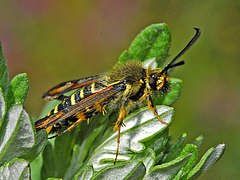Bembecia ichneumoniformis
| Bembecia ichneumoniformis | |
|---|---|

| |
| Bembecia ichneumoniformis. Male | |

| |
| Female | |
| Scientific classification | |
| Kingdom: | |
| Phylum: | |
| Class: | |
| Order: | |
| Family: | |
| Genus: | |
| Species: | B. ichneumoniformis
|
| Binomial name | |
| Bembecia ichneumoniformis ([Denis & Schiffermüller], 1775)
| |
| Synonyms[1] | |
|
List
| |
Bembecia ichneumoniformis, the six-belted clearwing, is a moth of the family Sesiidae.
Distribution
This species can be found in most of Europe and Asia Minor, the Caucasus, northern Iran and the Near East.[2][3]
Habitat
Bembecia ichneumoniformis prefers calcareous soils, sea-cliffs and quarries.
Description
The wingspan of Bembecia ichneumoniformis can reach 15–21 millimetres (0.59–0.83 in). The body of these moths is black, with six yellow narrow transversal bands in males (hence the common name), while the females may have only five yellow bands.[4] Antennae are relatively thick. In males they are usually black, while in the females they may be either black with an ocher band or basically ocher with a black apex. The front wings show a yellowish or orange apex, a yellow orange spot separating two transparent areas and brownish orange margins. The abdominal brush is black with yellow lines. Legs are yellow.
Rather similar species are Pyropteron muscaeformis, Bembecia scopigera and Bembecia albanensis.
Like all the butterflies of the family Sesiidae, this species is similar in appearance and flight to a hymenopteran more than to a lepidopteran. The wings are partially free of scales (transparent areas) and narrower and more elongated than those of other butterfly families. In fact the Latin name ichneumoniformis means that its shape and colors, as well as the structure of its wings, evokes certain ichneumonids, not a butterfly.
It is likely that the alternating yellow and black bands protects this species from certain predators that associate these colors with those of insects with darts and venom such as wasps and bees.
Biology
Adults are on wing from June to August in western Europe. It is a day-flying species.
The larvae feed on the roots of Lotus species and Anthyllis vulneraria. Other recorded food plants include Lotus corniculatus, Ononis spinosa, Dorycnium pentaphyllum, Dorycnium germanicum, Dorycnium herbaceum, Dorycnium hirsutum, Medicago, Hippocrepis comosa, Lupinus polyphyllus, Tetragonolobus maritimus and Lathyrus pratensis.[3]
The caterpillar may be parasitized by other insects, particularly by Tachinidae species (especially Bithia demotica and Bithia proletaria, Bithia glirina and Leskia aurea).[5]
Males are attracted by certain molecules, some of which also attract other species of butterflies (Tineidae et Choreutidae).[6]
Gallery
-
Illustration from John Curtis's British Entomology Volume 5
-
Bembecia ichneumoniformis. Male, side view
-
Female, side view
-
Close-up on abdominal brush
Bibliography
- Jackie A. McKern, Allen L. Szalanski, Donn T. Johnson, and Ashley P. G. Dowling, Molecular Phylogeny of Sesiidae (Lepidoptera) Inferred From Mitochondrial DNA Sequences ; J. Agric. Urban Entomol. 25(3): 165–177 (July 2008)
- B Verdcourt, Additions to the Wild Fauna and Flora of the Royal Botanic Gardens, Kew XXXV. Miscellaneous Records - Kew Bulletin, 2004 - (Lien vers JSTOR)
References
- ^ Checklist of the Sesiidae of the world (Lepidoptera: Ditrysia)
- ^ Fauna europaea
- ^ a b Funet
- ^ "Six-belted Clearwing". Butterfly Conservation. Retrieved 27 June 2019.
- ^ Æeljko Predovnik & Hans-Peter Tschorsnig, Tachinidae (Diptera) Rearded from clearwing moths (Lepidptera: Sesiidae) in Slovenia, Acta entomoligca Slovenica Ljubljana, July 2007, Vol. 15, øt. 1: 47–50 (Article)
- ^ V. Būda, U. Mäeorg, V. Karalius, G. H. L. Rothschild, S. Kolonistova, P. Ivinskis and R. Mozūraitis, C18 Dienes as attractants for eighteen clearwing (Sesiidae), tineid (Tineidae), and choreutid (Choreutidae) moth species ; Journal of Chemical Ecology ; Volume 19, Number 4, 799-813, doi:10.1007/BF00985010
External links
- UKmoths
- Lepiforum
- Paolo Mazzei, Daniel Morel, Raniero Panfili Moths and Butterflies of Europe and North Africa
- Svenska fjärilar




